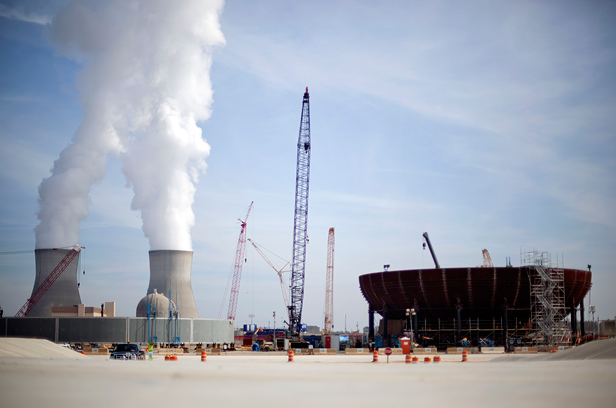A Glut of Natural Gas Leaves Nuclear Power Stalled
The outlook is bleak in the U.S. and complicated in other countries.
The nuclear renaissance is in danger of petering out before it has even begun, but not for the reasons most people once thought. Forget safety concerns, or the problem of where to store nuclear waste—the issue is simply cheap, abundant natural gas.
General Electric CEO Jeffrey Immelt caused a stir last month when he told the Financial Times that it’s “hard to justify nuclear” in light of low natural gas prices. Since GE sells all manner of power generation equipment, including components for nuclear plants, Immelt’s comments hold a lot of weight.
Cheap natural gas has become the fuel of choice with electric utilities, making building expensive new nuclear plants an increasingly tough sell. The United States is awash in natural gas largely thanks to horizontal drilling and hydraulic fracturing, or “fracking” technology, which allows drillers to extract gas from shale deposits once considered too difficult to reach. In 2008, gas prices were approaching $13 per million BTUs; prices have now dropped to around $3.
This story is only available to subscribers.
Don’t settle for half the story.
Get paywall-free access to technology news for the here and now.
Subscribe now
Already a subscriber?
Sign in
When gas prices were climbing, there were about 30 nuclear plant projects in various stages of planning in the United States. Now the Nuclear Energy Institute estimates that, at most, five plants will be built by 2020, and those will only be built thanks to favorable financing terms and the ability to pay for construction from consumers’ current utility bills. Two reactors now under construction in Georgia, for example, moved ahead with the aid of an $8.33 billion loan guarantee from the U.S. Department of Energy.
What happens after those planned projects is hard to predict. “The question is whether we’ll see any new nuclear,” says Revis James, the director of generation research and development at the Electric Power Research Institute. “The prospects are not good.”
Outside the United States, it’s a different story. Unconventional sources of natural gas also threaten the expansion of nuclear, although the potential impact is less clear-cut. Around the world, there are 70 plants now under construction, but shale gas also looms as a key factor in planning for the future. Prices for natural gas are already higher in Asia and Europe, and shale gas resources are not as fully developed as they are the United States.
Some countries are also blocking the development of new natural gas resources. France, for instance, which has a strong commitment to nuclear, has banned fracking in shale gas exploration because of concerns over the environmental impact.
Fast-growing China, meanwhile, needs all the energy sources available and is building nuclear power plants as fast as possible.
Even in United States, of course, super cheap natural gas will not last forever. With supply exceeding demand, some drillers are said to be losing money on natural gas, which could push prices back up. Prices will also be pushed upward by utilities, as they come to rely on more natural gas for power generation, says James.
Ali Azad, the chief business development officer at energy company Babcock & Wilcox, thinks the answer is making nuclear power smaller, cheaper, and faster. His is one of a handful of companies developing small modular reactors that can be built in three years, rather than 10 or more, for a fraction of the cost of gigawatt-size reactors. Although this technology is not yet commercially proven, the company has a customer in the Tennessee Valley Authority, which expects to have its first unit online in 2021 (see “A Preassembled Nuclear Reactor”).
“When we arrive, we will have a level cost of energy on the grid, which competes favorably with a brand-new combined-cycle natural gas plants when gas prices are between $6 to $8,” said Azad. He sees strong demand in power-hungry China and places such as Saudia Arabia, where power is needed for desalination.
Even if natural gas remains cheaper, utilities don’t want to find themselves with an overreliance on gas, which has been volatile on price in the past, so nuclear power will still contribute to the energy mix. “[Utilities] still continue [with nuclear] but with a lower level of enthusiasm—it’s a hedging strategy,” says Hans-Holger Rogner from the Planning and Economics Studies section of the International Atomic Energy Agency. “They don’t want to pull all their eggs in one basket because of the new kid on the block called shale gas.”
